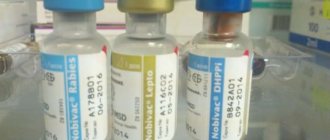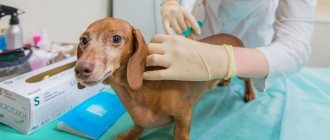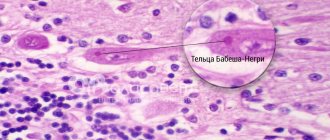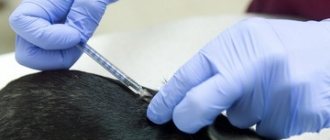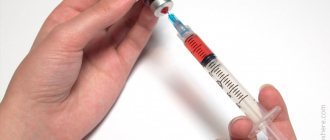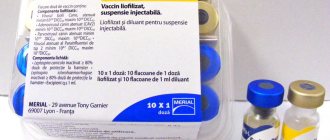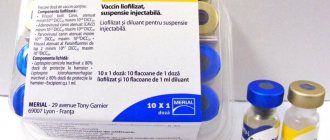Vaccination of dogs not only helps to curb the growth of viral epidemics, but also keeps tailed pets healthy. After all, how long a pet will live directly depends on whether it has been vaccinated, because thanks to vaccinations, the number of diseases such as plague and viral enteritis has significantly decreased. For best effectiveness, you must follow the vaccination schedule. When the immunization schedule is accurately followed, we can say that the pet has immunity that can cope with dangerous infectious and viral diseases. In our article we will reveal the basic rules for vaccinating dogs and include such important information as a table with a detailed schedule of the vaccination period.
Vaccination rules
Every owner should know that dogs are vaccinated based on the vaccination schedule. However, there are situations in which vaccinations are not necessary:
- Injections should not be given to babies under 2 months of age. When puppies are newborns, they are protected by maternal immunity, provided that the mother dog has been vaccinated. This protection lasts no more than 6 weeks, then it weakens. There is no need to vaccinate puppies before 8 weeks, because the level of maternal antibodies will decrease, and acquired immunity will not develop, and the pet will not be protected against infection.
- Vaccination can only be carried out if the animal is healthy; even if there is a slight illness, vaccination is not necessary.
- When is the dog scheduled to be bred? The vaccine should be given 3 months before, because a later vaccination will cause various defects in the offspring.
- It is advisable that puppies be vaccinated before or after the teething period. Because some vaccines can cause tooth enamel to darken.
- 2 weeks before the vaccination, puppies need to undergo not only deworming, but also flea treatment.
- If your pet has had a negative reaction to the primary vaccination or is suffering from allergies. Before administering the vaccine, she needs to be given an injection of Suprastin or Tavegil; the drug can be given in tablets.
- After receiving the vaccine, some dogs may react with anaphylactic shock and will require immediate veterinary attention. Therefore, it is advisable to spend half an hour after administering the drug near the clinic, but you should not walk on the street. It is better to wait out this time not within the walls of the clinic, but in the car.
All vaccination marks must be included in the veterinary passport, since it is considered an important document for the dog and is needed when traveling abroad, when visiting an exhibition, or traveling around the country.
If you pick up a puppy on the street, then there is no need to rush to vaccinate him, it is better to check him for the presence of antibodies to infections, maybe he has already been vaccinated.
Primary vaccination
Vaccinations for puppies up to one year old are of great importance; they are usually given when the baby is 2 months old. Below is a schedule of vaccinations for puppies in their first year of life. The first vaccine is important for the baby; it is considered the most difficult for him. Much attention must be paid to such an aspect as the health of the puppy. It is important that there is no contact with animals; until the first vaccine is given, you should not walk on the street. It is better to quarantine the dog, that is, do not go for walks, do not go to the baby in outerwear, it is important that neither other animals nor people approach the puppy. It is necessary to give anthelmintics 7 days in advance; 3 days in advance it is important to monitor the pet’s well-being, its appetite, behavior, and temperature. You can give dogs their first vaccinations according to age only if the pet’s condition does not cause concern.
Revaccination
The next 14 days are a difficult time. When a puppy has a weakened body, he may need the help of a veterinarian; he should not be left alone for a long time, and he should not be taken for walks. To strengthen immunity, after 2 weeks the puppy is given a second vaccination with the same vaccine. Revaccination, as a rule, is easier to tolerate, and the puppy can go for walks outside after 3 days.
Vaccination schedule
Vaccination of dogs is carried out according to a schedule, i.e., in compliance with a certain frequency and time frame. This is due to the peculiarities of the formation of the animal’s immune status. The first vaccination is carried out no earlier than three months from the birth of the puppy. Until this age, immunity is given to the baby through mother's milk. If for some reason breastfeeding was not carried out, then the start date for vaccination may be slightly adjusted.
Vaccinations for adult dogs
It is necessary to vaccinate not only puppies, but also adult dogs; they also need protection from infections. The vaccination schedule for an adult animal recommends an injection every 12 months. It is necessary to vaccinate against rabies every year, and other types are allowed to be administered once every 2-3 years, but this is subject to the absolute health of the dog. Rabies vaccination is often included in a comprehensive vaccination program.
When a dog reaches 8 years of age, mandatory vaccinations depend on its health. If your pet has chronic diseases, you can refuse vaccination, as it can only worsen the dog’s condition. However, the owner does not have the right to refuse rabies vaccination, as this is prohibited by law.
Can a vaccine be harmful?
With the help of a vaccine, a virus is introduced into the animal’s body, which has been weakened or killed by special manipulations. To develop immunity, the puppy must have a lot of strength and no health problems. Otherwise, it will be difficult for the defense mechanism to overcome hostile bodies, and the baby may become infected with the drug for which he was injected.
To prevent such cases, it is prohibited to vaccinate:
- weakened and sick dogs;
- puppies that have been in contact with presumably sick animals;
- medications that have expired or whose storage and transportation conditions have been violated: under direct sunlight, in conditions of high temperature or humidity;
- if there is a possibility that the kitten is infected;
- if less than 2 weeks have passed since antibiotic therapy;
- before and after any surgical interventions.
If you suspect that your pet has any disease, including the one against which vaccination is being carried out, it is necessary to submit urine and blood for testing. Their result will make it possible to verify the absence or presence of the virus in the baby, even if there are no characteristic manifestations of infection.
Vaccination table for puppies in their first year of life
The table below will help you figure out what vaccinations puppies receive:
| Dog age | What is the vaccine for? | Notes |
| 1 month | Vaccination series PUPPY | Do as needed |
| 8-10 weeks | From plague, enteritis, hepatitis, parainfluenza, leptospirosis | Primary vaccination |
| 11-13 weeks | From plague, parainfluenza, hepatitis, enteritis, leptospirosis | Revaccination |
| 11-13 weeks | For rabies | Primary vaccination |
| 6-7 months | From plague, parainfluenza, plague, enteritis, hepatitis, leptospirosis | Repeated vaccination |
| 6-7 months | For rabies | Repeated vaccination, then after a year |
| 1 year | From plague, parainfluenza, hepatitis, leptospirosis, enteritis | Repeated vaccination, then after a year |
The spread of rabies – horror stories or real losses?
In 2022, at the largest annual National Veterinary Conference (NVC), the results on rabies were summed up.
Calculations were carried out, from which it follows that at the moment dogs (39%), foxes (25%), cats (24%), raccoon dogs (6%), small and cattle (2 each) are considered carriers and vectors of rabies. %) and hedgehogs (2%).
According to the World Health Organization (WHO), about 60 thousand people die from rabies every year worldwide, 40% of whom are children under 15 years of age. Every year in Russia there are 400-450 thousand people affected by attacks by street animals.
For such victims, a huge budget is allocated for therapeutic and preventive therapy: the introduction of anti-rabies immunoglobulins and vaccination of people against rabies. In December 2019 alone, 132 cases of rabies were recorded in Russia. Until now, the epidemiological situation regarding the incidence of rabies in Russia remains unstable - from 2012 to the present, 30 deaths among people have been registered.
In the Moscow region in 2022 and the first half of 2019, a worsening of the epizootic situation regarding rabies was revealed. There is a very high number of people seeking help from medical institutions after being injured by animals, and deaths have also been recorded. In just 6 months in 2022, more than 198 thousand people applied, of which more than 53 thousand were children under 14 years of age.
How is rabies transmitted?
Exceptions to the rules
Sometimes the vaccination schedule may shift. Typically, this may be influenced by the following factors:
- Epidemiological situation in the area. The standard vaccination schedule may change based on dangerous outbreaks of infection. In this case, puppies can begin to be vaccinated at one month of age with special vaccines.
- Being forced to move early can also shift your schedule. In this case, you must adhere to the following rule: vaccination should be given no earlier than one month of age and no later than 10 days before the planned trip.
- Particular attention should be paid to puppies raised without a mother; a very important factor is how many days the first vaccination was given. Since, on the one hand, they need to increase their immunity, and on the other, try to carry out immunization in the most gentle manner. They can begin vaccination at 6 weeks of age, and subsequently reinforced at 9 or 12 weeks.
Treatment for fleas, ticks and other external parasites
Various drugs are suitable for these purposes:
- sprays;
- drops;
- shampoos;
- collars;
- powders;
- solutions, etc.
Antiparasitic collars are not complete protection against fleas and ticks, but they perfectly complement, enhance and prolong the effect of the main drug. For this reason, it is advisable to combine several options for insectoacaricidal (antiparasitic) drugs.
Medicines are chosen individually, taking into account the composition. Different medications are used for puppies, adults and elderly pets. The dose is determined based on the weight and size of the pet.
You need to pay particular attention to the dosage when using anti-flea drops and sprays. Special shampoos, solutions and powders are easier to dose - no such precision is required.
The manufacturer indicates detailed instructions for use of each drug on the packaging, but there are general rules for all such drugs. It is necessary to ensure that the drug gets on the dog’s skin without remaining on the fur. Use medications against ectoparasites with caution in pets with skin lesions and other dermatological problems.
It is not advisable to pet or hug your pet within 12 to 24 hours after flea treatment.
Effective insectoacaricidal preparations are Advantix, Frontline, Kiltix, Hearts, Brovecto, Celandine, Dana, Bars and some other imported (Holland, Germany, Czech Republic) and domestic products.
Complications
Many owners are afraid not so much of the vaccination itself, but of the complications it can cause. At the moment, the complex vaccine administered to dogs is of high quality, and side effects occur extremely rarely, but their occurrence cannot be completely excluded. The first post-vaccination day is considered the most difficult, and the dog needs to be given increased attention during this time. If the pet is apathetic and lethargic, refuses to eat, and has a slight rise in temperature, then there is nothing to worry about. Many people wonder how long such symptoms can last. The next day everything should go away. If after a day there is no improvement, the dog has a fever, vomiting, diarrhea, drooling, or convulsions, then it is necessary to immediately consult a veterinarian.
As soon as the long-awaited dog appears in the house, the owner needs to decide on a clinic, since it not only needs love, but also protection. The veterinarian will help you choose an individual vaccination schedule, which will determine not only your life expectancy, but also your health.
A terrible road from bite to death
Any person needs to know how humans and dogs are infected with the rabies virus, and what symptoms indicate the presence of a fatal disease.
The rabies virus is transmitted in saliva when bitten by a sick animal. Spreading along the nerve fibers, the pathogen enters the spinal cord, then into the nerve cells of the cerebral cortex, and then affects the hippocampus and bulbar centers, causing inflammation and severe disorders in them, leading to death. Shortly before death, the virus reaches the salivary glands so that it can enter another body through saliva.
And now more details in simple words. A sick animal (fox, cat or dog) bites a healthy dog or person, transmitting the rabies virus through saliva at the time of the bite. In the resulting wound (in muscles and connective tissue), the pathogen begins to multiply - this process can be either fast (about 7 days) or very long (up to 1 year), even though the wound itself has already healed. This period is called incubation, i.e. The pathogen has entered the body, but there are no symptoms of the disease yet.
The development of the disease is associated with the location of the bite, so the rate of spread of the virus throughout the body will be increased if the resulting injury is close to the brain (muzzle, neck, front paw). The duration of the incubation period depends on this important point. It is at this moment (before the first symptoms) that active treatment should be started - this gives a high chance of not dying from rabies. But you can read more about this below in the article.
Timer started
Once the first symptoms of the disease appear, unfortunately, it is no longer possible to cure rabies. Once the virus has multiplied sufficiently, it will begin to travel along the centripetal nerves (the nerves that “go” to the central nervous system) to the spinal nerve ganglia. From the nodes, the virus passes into the substance of the spinal cord and brain, thereby entering the central nervous system and causing the death of nerve cells (neurons).
Along the nerve endings, the virus also enters the salivary glands of the patient, which is why the saliva becomes dangerous to others during a bite or when licking a damaged surface of a still healthy animal or person (for example, arms or legs).
Spread of the virus in the dog's body
Symptoms in humans
In a person, it will all start with numbness and itching in the area of the injury for 1-3 days. Further, at the first damage to nerve cells, people develop symptoms such as depression, lethargy, apathy, anxiety, insomnia, and elevated body temperature.
At the next stage of development of the disease, excitement increases over 1-4 days - the sick person becomes very aggressive and violent, he is irritated by bright light and any sound, and noise causes muscle spasms in the limbs. Active salivation, aerophobia, fear of hydrophobia, hallucinations and a feeling of fear develop.
Aerophobia is muscle cramps that occur even with the slightest movement of air. Hydrophobia is a special reaction to the appearance of water, the sounds of its overflow, and even to the offer of a drink. At this moment, a spasm of the respiratory muscles occurs, pharyngeal convulsions begin, and the person falls into horror.
The final stage in the development of rabies is paralysis of the eye and zygomatic muscles (jaw droops), as well as complete paralysis of the muscles of the limbs. The person no longer exists as an individual. Massive death of nerve cells leads to damage to the cardiovascular and respiratory centers, which 100% entails death from suffocation due to paralysis of the respiratory muscles.
Symptoms in dogs and cats
The duration of the disease from the appearance of the first symptoms to the death of the animal is 6-11 days. Rabies occurs in one of two forms.
| Aggressive form of rabies | Silent form of rabies |
| The most basic and well-known form of the disease | The most dangerous form of the disease |
| Excessive drooling - the lower jaw, legs and front paws will be wet with foamy saliva. The animal looks very unkempt and dirty. | The animal is calm, does not react to external stimuli and does not try to bite anyone at all. |
| Sometimes the pet experiences an increase in body temperature, lacks appetite due to paralysis of the larynx, and exhibits a fear of water, light, and people. | The pet can become extremely affectionate (trying to lick), which has never previously manifested itself in ordinary life. |
| Overt, very aggressive behavior - the animal is excited, violently grabs objects, strives to break free from a leash, bites everything that moves. The goal is to infect as many other pets and people as possible with the virus. | Infection occurs when licking the hands, feet of a person or the muzzle and paws of a healthy animal with microtraumas on the surface of the skin. |
| Neurological symptoms – paralysis of limbs, strange gait, coma, death of the animal | |
How does rabies manifest in dogs? Aggressive form.
How does rabies manifest in dogs? Quiet form.
